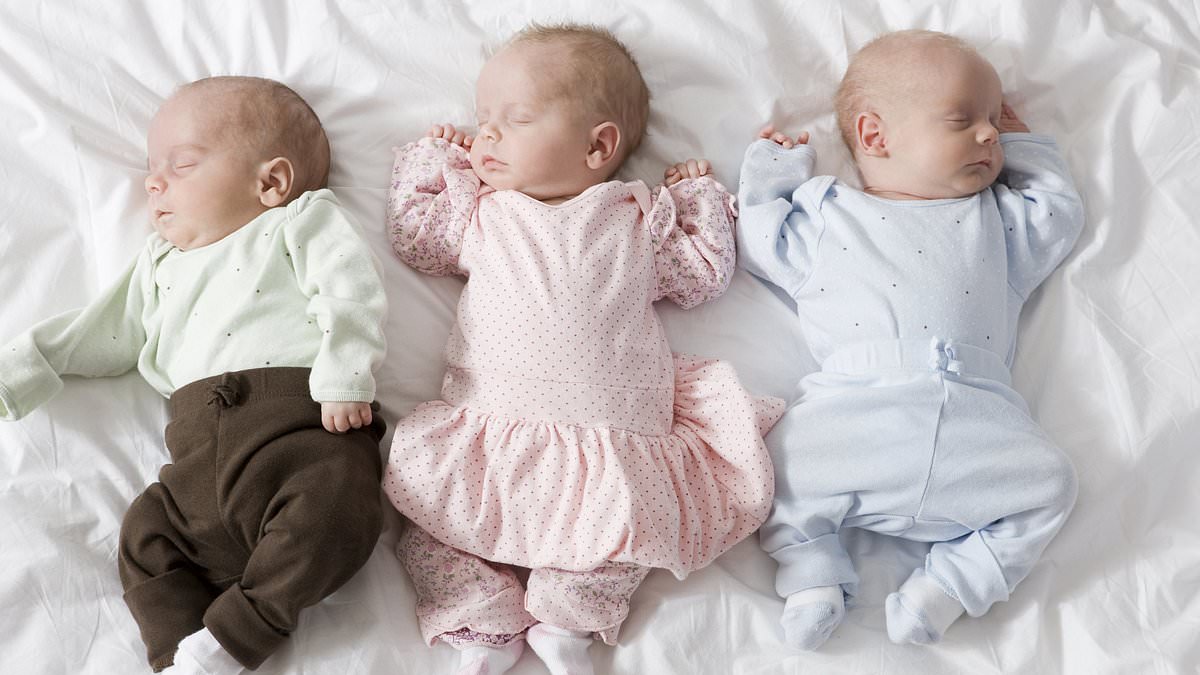The birth rate of triplets has more than halved over the past three decades, the CDC reports.
The CDC said Thursday the rate of triplets and higher multiple-births dropped from 193.5 per 100,000 births in 1998 to 73.8 per 100,000 births in 2023.
And the largest declines were between 2009 to 2023.
Researchers attribute the plunge mainly to changes in fertility treatments and methods.
In the past, it was common place for a fertility doctor to implant two or more fertilized embryos into a woman’s uterus after in-vitro fertilization (IVF), to increase the likelihood one would develop and produce a pregnancy.
This leads to more instances of twins, triplets and quadruplets from 1980 to 1998, as fertility treatments became more advanced, affordable and accessible. By the mid 1990s, 30 percent of all IVF pregnancies resulted in twins, triplets or higher-order births.
However, doctors became concerned about the number of twins and triplets being born to people using IVF, since a pregnancy with more than one fetus is more likely to have complications than a single-fetus pregnancy.
This includes a higher likelihood of pre-term birth, miscarriage and conditions like pre-eclampsia, where the blood pressure during pregnancy gets dangerously high.
So, beginning in the early 2000s doctors began passing regulations on the number of embryos that could be implanted during IVF, issuing new guidelines almost every two years up until 2004, resulting in fewer multiple births.

The National Center for Health Statistics tracked data for triplet or higher order pregnancies for more than two decades

In natural births, about one in every 10,000 births is a set of triplets. Adding in triplets born from IVF, the rate of triplets in pregnancy is about 7.38 per 10,000 births.
Dr Amanda Williams, the chief medical officer at March of Dimes, a nonprofit focused on maternal health, said having multi-birth pregnancies can be significantly more dangerous, risking the health of the mother and the fetus.
On the whole, Dr Williams said, told CNN, ‘this is good news for families, because triplets and higher-order pregnancies are so much riskier for mom and baby.’
The latest recommendations by the American Society for Reproductive Medicine recommend only implanting one embryo at a time in a woman undergoing IVF under 35, and no more than four embryos at a time in a woman undergoing IVF above age 40.
About 240,000 women undergo IVF every year, during which a woman’s egg is fertilized with sperm outside of the body and then implanted into her uterus in hopes of producing a viable pregnancy.
The new CDC report uses data from the National Center for Health Statistics, which is a branch of the CDC, and it looks at births in the US since 1998.
The decline from 1998 to 2023 was larger in some demographics compared to others – which epidemiologists say may be because certain groups, like white people, had access to IVF treatments earlier than others.
In white women, the triplet and higher order birth rate fell 71 percent since 1998. In Hispanic women, the triplet and higher order birth rate fell 25 percent since 1998.
The rate of conceiving triplets naturally hasn’t appeared to changed significantly, but since it’s a rare event, it doesn’t skew the data from IVF trends.
About one in every 10,000 pregnancies is a natural set of triplets, according to Hillcrest Medical Center.










